Abstract
Freshly isolated mononuclear leukocytes have been reported to show changes in cholesterol synthesis and high-affinity degradation of low-density lipoproteins (LDL) that parallel those that occur in the liver. To examine whether hypolipidemic therapy in patients with heterozygous familial hypercholesterolemia influences cholesterol homeostasis in their mononuclear cells we assessed the effects of colestipol and nicotinic acid (alone and in combination) on the rates of high-affinity 125I-labeled LDL degradation and on the rates of cholesterol and phosphatidylcholine biosynthesis by freshly isolated cells. Rates of 125I-labeled LDL degradation were lower in mononuclear cells from patients with heterozygous familial hypercholesterolemia on no medication (3.1 ng per 4 X 10(6) cells per 5 hr) than in cells from normal control subjects (6.1 ng per 4 X 10(6) cells per 5 hr) and, in the former patients, the values were not significantly affected by therapy with nicotinic acid. In contrast, freshly isolated mononuclear cells from patients receiving colestipol degraded 125I-labeled LDL at near-normal rates (5.0 ng per 4 X 10(6) cells per 5 hr). The rates of cholesterol synthesis were also higher in mononuclear cells isolated from patients treated with colestipol than in cells from untreated patients or from those receiving nicotinic acid; in contrast the rate of synthesis of phosphatidylcholine did not show any consistent changes. Similar results were obtained in a smaller number of patients studied longitudinally, in which colestipol therapy significantly increased rates of cholesterol synthesis and high-affinity degradation of 125I-labeled LDL by freshly isolated mononuclear cells. We conclude that previously observed changes in cholesterol homeostasis in the liver of patients treated with bile acid sequestrants are paralleled by similar changes in freshly isolated mononuclear cells and that these cells offer an accessible model for further studies on how diet and pharmacologic agents influence cellular cholesterol homeostasis in humans.
Full text
PDF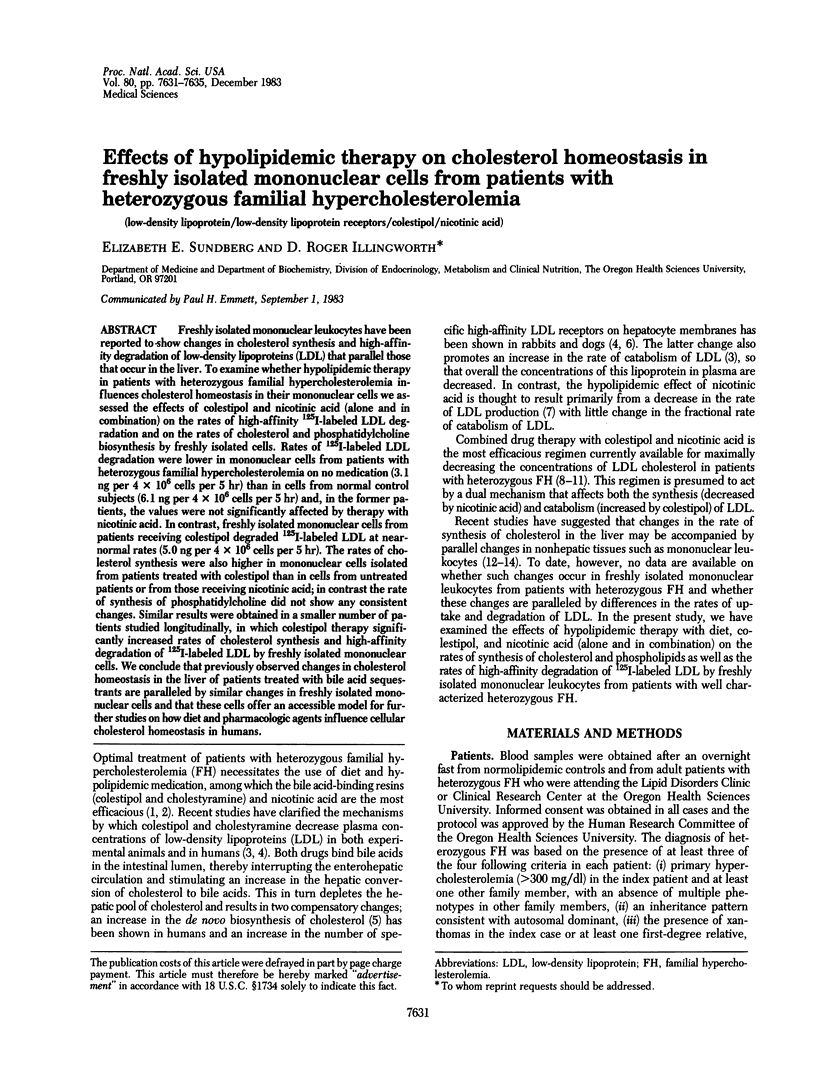
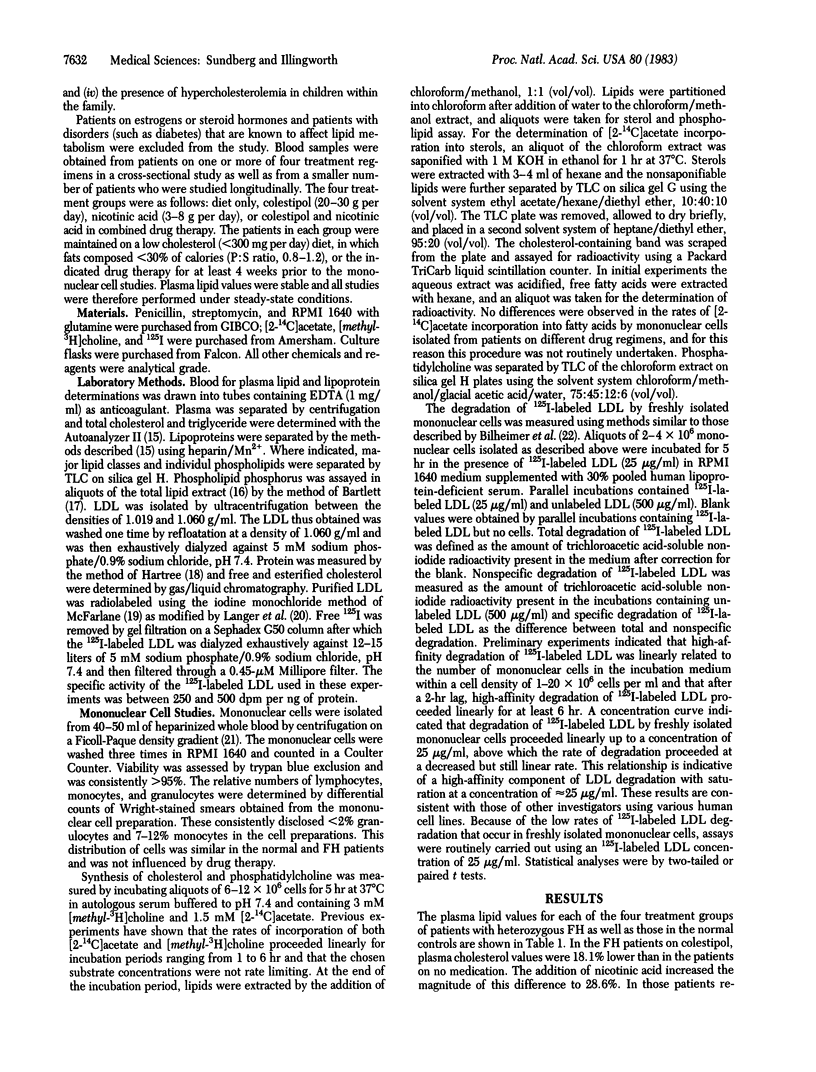
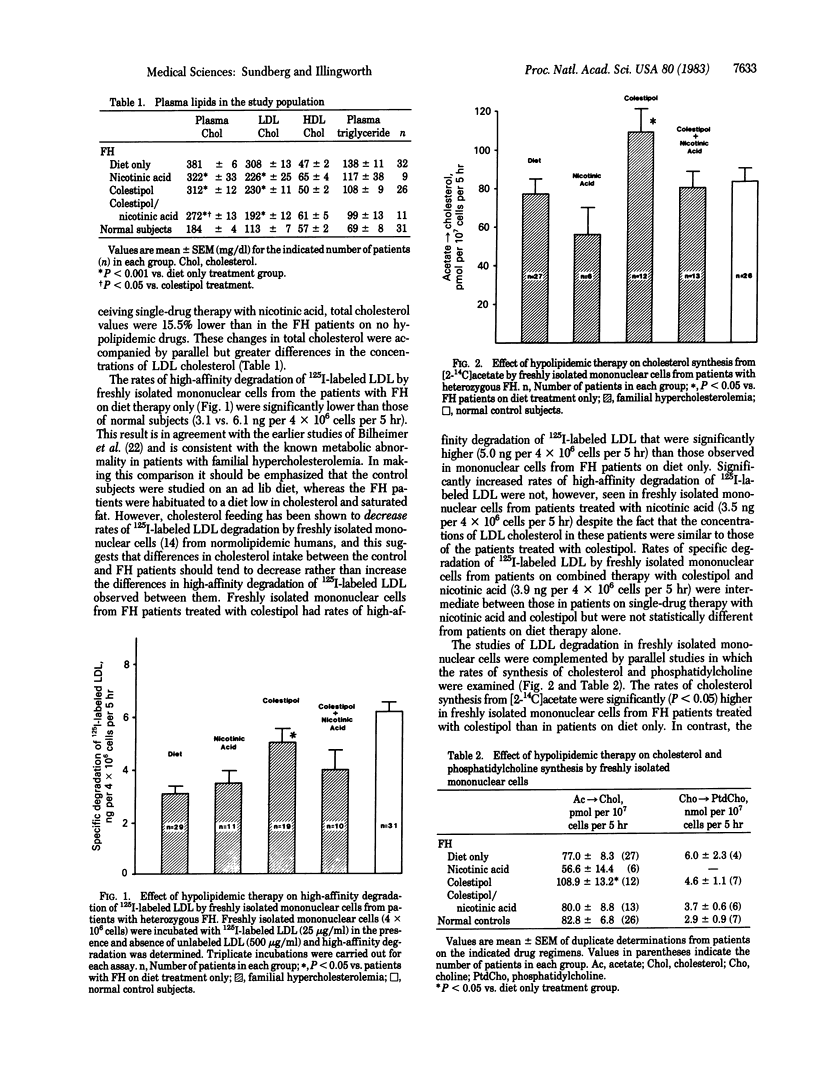
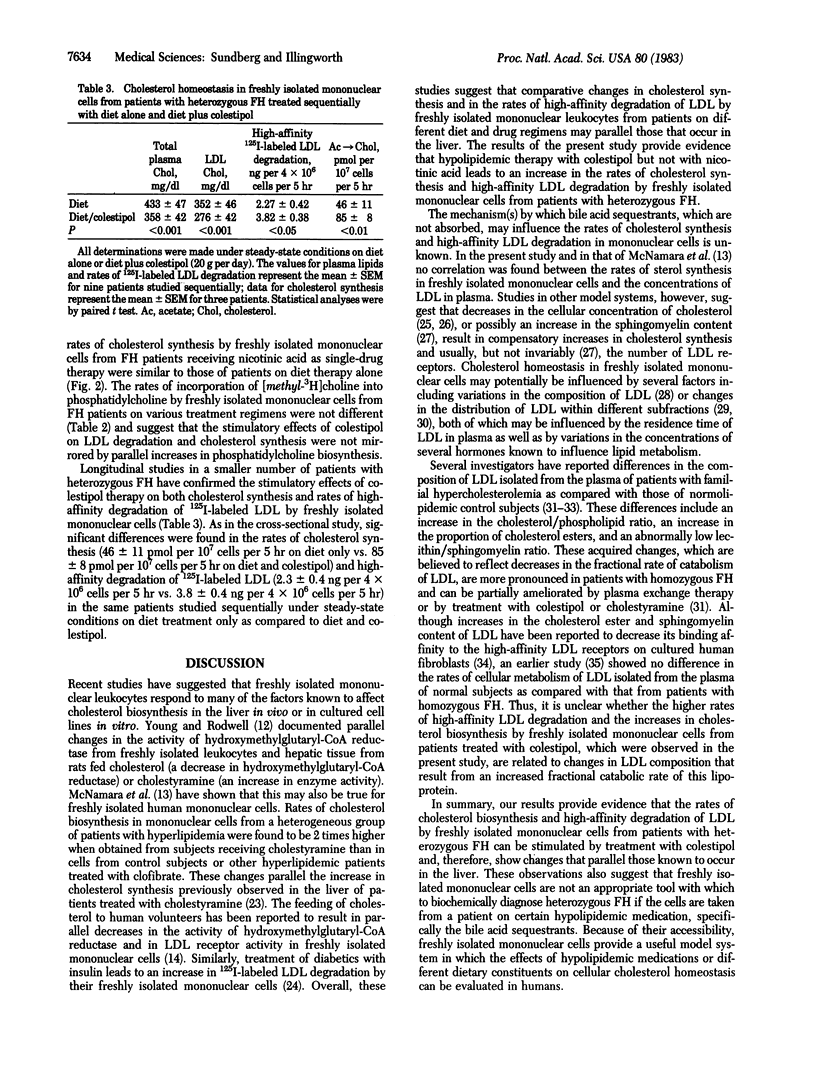
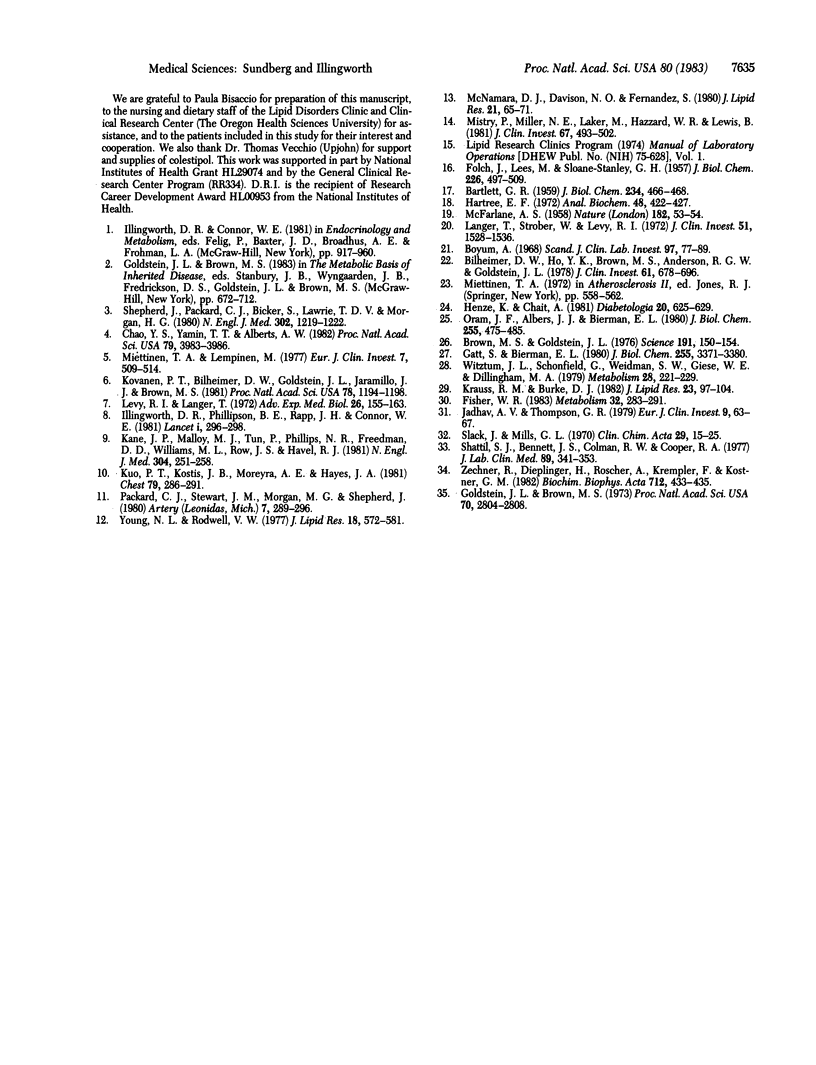
Selected References
These references are in PubMed. This may not be the complete list of references from this article.
- BARTLETT G. R. Phosphorus assay in column chromatography. J Biol Chem. 1959 Mar;234(3):466–468. [PubMed] [Google Scholar]
- Bilheimer D. W., Ho Y. K., Brown M. S., Anderson R. G., Goldstein J. L. Genetics of the low density lipoprotein receptor. Diminished receptor activity in lymphocytes from heterozygotes with familial hypercholesterolemia. J Clin Invest. 1978 Mar;61(3):678–696. doi: 10.1172/JCI108980. [DOI] [PMC free article] [PubMed] [Google Scholar]
- Brown M. S., Goldstein J. L. Receptor-mediated control of cholesterol metabolism. Science. 1976 Jan 16;191(4223):150–154. doi: 10.1126/science.174194. [DOI] [PubMed] [Google Scholar]
- Böyum A. Isolation of mononuclear cells and granulocytes from human blood. Isolation of monuclear cells by one centrifugation, and of granulocytes by combining centrifugation and sedimentation at 1 g. Scand J Clin Lab Invest Suppl. 1968;97:77–89. [PubMed] [Google Scholar]
- Chao Y. S., Yamin T. T., Alberts A. W. Catabolism of low density lipoproteins by perfused rabbit livers: cholestyramine promotes receptor-dependent hepatic catabolism of low density lipoproteins. Proc Natl Acad Sci U S A. 1982 Jul;79(13):3983–3986. doi: 10.1073/pnas.79.13.3983. [DOI] [PMC free article] [PubMed] [Google Scholar]
- FOLCH J., LEES M., SLOANE STANLEY G. H. A simple method for the isolation and purification of total lipides from animal tissues. J Biol Chem. 1957 May;226(1):497–509. [PubMed] [Google Scholar]
- Fisher W. R. Heterogeneity of plasma low density lipoproteins manifestations of the physiologic phenomenon in man. Metabolism. 1983 Mar;32(3):283–291. doi: 10.1016/0026-0495(83)90194-4. [DOI] [PubMed] [Google Scholar]
- Gatt S., Bierman E. L. Sphingomyelin suppresses the binding and utilization of low density lipoproteins by skin fibroblasts. J Biol Chem. 1980 Apr 25;255(8):3371–3376. [PubMed] [Google Scholar]
- Goldstein J. L., Brown M. S. Familial hypercholesterolemia: identification of a defect in the regulation of 3-hydroxy-3-methylglutaryl coenzyme A reductase activity associated with overproduction of cholesterol. Proc Natl Acad Sci U S A. 1973 Oct;70(10):2804–2808. doi: 10.1073/pnas.70.10.2804. [DOI] [PMC free article] [PubMed] [Google Scholar]
- Hartree E. F. Determination of protein: a modification of the Lowry method that gives a linear photometric response. Anal Biochem. 1972 Aug;48(2):422–427. doi: 10.1016/0003-2697(72)90094-2. [DOI] [PubMed] [Google Scholar]
- Henze K., Chait A. Lysosomal enzyme activities and low density lipoprotein receptors in circulating mononuclear cells. Effect of insulin therapy in diabetic patients. Diabetologia. 1981 Jun;20(6):625–629. doi: 10.1007/BF00257431. [DOI] [PubMed] [Google Scholar]
- Illingworth D. R., Phillipson B. E., Rapp J. H., Connor W. E. Colestipol plus nicotinic acid in treatment of heterozygous familial hypercholesterolaemia. Lancet. 1981 Feb 7;1(8215):296–298. doi: 10.1016/s0140-6736(81)91910-3. [DOI] [PubMed] [Google Scholar]
- Jadhav A. V., Thompson G. R. Reversible abnormalities of low density lipoprotein composition in familial hypercholesterolaemia. Eur J Clin Invest. 1979 Feb;9(1):63–67. doi: 10.1111/j.1365-2362.1979.tb01668.x. [DOI] [PubMed] [Google Scholar]
- Kane J. P., Malloy M. J., Tun P., Phillips N. R., Freedman D. D., Williams M. L., Rowe J. S., Havel R. J. Normalization of low-density-lipoprotein levels in heterozygous familial hypercholesterolemia with a combined drug regimen. N Engl J Med. 1981 Jan 29;304(5):251–258. doi: 10.1056/NEJM198101293040502. [DOI] [PubMed] [Google Scholar]
- Kovanen P. T., Bilheimer D. W., Goldstein J. L., Jaramillo J. J., Brown M. S. Regulatory role for hepatic low density lipoprotein receptors in vivo in the dog. Proc Natl Acad Sci U S A. 1981 Feb;78(2):1194–1198. doi: 10.1073/pnas.78.2.1194. [DOI] [PMC free article] [PubMed] [Google Scholar]
- Krauss R. M., Burke D. J. Identification of multiple subclasses of plasma low density lipoproteins in normal humans. J Lipid Res. 1982 Jan;23(1):97–104. [PubMed] [Google Scholar]
- Kuo P. T., Kostis J. B., Moreyra A. E., Hayes J. A. Familial type II hyperlipoproteinemia with coronary heart disease: effect of diet-colestipol-nicotinic acid treatment. Chest. 1981 Mar;79(3):286–291. doi: 10.1378/chest.79.3.286. [DOI] [PubMed] [Google Scholar]
- Langer T., Strober W., Levy R. I. The metabolism of low density lipoprotein in familial type II hyperlipoproteinemia. J Clin Invest. 1972 Jun;51(6):1528–1536. doi: 10.1172/JCI106949. [DOI] [PMC free article] [PubMed] [Google Scholar]
- Levy R. I., Langer T. Hypolipidemic drugs and lipoprotein metabolism. Adv Exp Med Biol. 1972;26(0):155–163. doi: 10.1007/978-1-4684-7547-0_13. [DOI] [PubMed] [Google Scholar]
- McFARLANE A. S. Efficient trace-labelling of proteins with iodine. Nature. 1958 Jul 5;182(4627):53–53. doi: 10.1038/182053a0. [DOI] [PubMed] [Google Scholar]
- McNamara D. J., Davidson N. O., Fernandez S. In vitro cholesterol synthesis in freshly isolated mononuclear cells of human blood: effect of in vivo administration of clofibrate and/or cholestyramine. J Lipid Res. 1980 Jan;21(1):65–71. [PubMed] [Google Scholar]
- Miettinen T. A., Lempinen M. Cholestyramine and ileal by-pass in the treatment of familial hypercholesterolaemia. Eur J Clin Invest. 1977 Dec;7(6):509–514. doi: 10.1111/j.1365-2362.1977.tb01644.x. [DOI] [PubMed] [Google Scholar]
- Mistry P., Miller N. E., Laker M., Hazzard W. R., Lewis B. Individual variation in the effects of dietary cholesterol on plasma lipoproteins and cellular cholesterol homeostasis in man. Studies of low density lipoprotein receptor activity and 3-hydroxy-3-methylglutaryl coenzyme A reductase activity in blood mononuclear cells. J Clin Invest. 1981 Feb;67(2):493–502. doi: 10.1172/JCI110058. [DOI] [PMC free article] [PubMed] [Google Scholar]
- Oram J. F., Albers J. J., Bierman E. L. Rapid regulation of the activity of the low density lipoprotein receptor of cultured human fibroblasts. J Biol Chem. 1980 Jan 25;255(2):475–485. [PubMed] [Google Scholar]
- Packard C. J., Stewart J. M., Morgan H. G., Lorimer A. R., Shepherd J. Combined drug therapy for familial hypercholesterolemia. Artery. 1980;7(4):281–289. [PubMed] [Google Scholar]
- Shattil S. J., Bennett J. S., Colman R. W., Cooper R. A. Abnormalities of cholesterol-phospholipid composition in platelets and low-density lipoproteins of human hyperbetalipoproteinemia. J Lab Clin Med. 1977 Feb;89(2):341–353. [PubMed] [Google Scholar]
- Shepherd J., Packard C. J., Bicker S., Lawrie T. D., Morgan H. G. Cholestyramine promotes receptor-mediated low-density-lipoprotein catabolism. N Engl J Med. 1980 May 29;302(22):1219–1222. doi: 10.1056/NEJM198005293022202. [DOI] [PubMed] [Google Scholar]
- Slack J., Mills G. L. Anomalous low density lipoproteins in familial hyperbetalipoproteinaemia. Clin Chim Acta. 1970 Jul;29(1):15–25. doi: 10.1016/0009-8981(70)90215-9. [DOI] [PubMed] [Google Scholar]
- Witztum J. L., Schonfeld G., Weidman S. W., Giese W. E., Dillingham M. A. Bile sequestrant therapy alters the compositions of low-density and high-density lipoproteins. Metabolism. 1979 Mar;28(3):221–229. doi: 10.1016/0026-0495(79)90067-2. [DOI] [PubMed] [Google Scholar]
- Young N. L., Rodwell V. W. Regulation of hydroxymethylglutaryl-CoA reductase in rat leukocytes. J Lipid Res. 1977 Sep;18(5):572–581. [PubMed] [Google Scholar]
- Zechner R., Dieplinger H., Roscher A., Krempler F., Kostner G. M. The role of lecithin:cholesterol acyltransferase for the low density lipoprotein composition and specific binding to the B receptor. Biochim Biophys Acta. 1982 Aug 18;712(2):433–435. doi: 10.1016/0005-2760(82)90365-4. [DOI] [PubMed] [Google Scholar]


